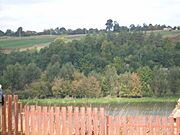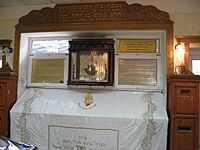Nachman of Breslov facts for kids
Quick facts for kids Nachman of Breslov |
|
|---|---|
| Breslover Rebbe | |
 |
|
| Born | 4 April 1772 (Rosh Chodesh Nisan 5532) Międzybóż, Kingdom of Poland |
| Died | 16 October 1810 (18 Tishrei 5571) Uman, Kyiv Governorate, Russian Empire |
| Buried | Uman, Russia, 17 October 1810 (19 Tishrei 5571) |
| Dynasty | Breslov |
| Father | Simcha |
| Mother | Feiga |
Nachman of Breslov (born April 4, 1772 – died October 16, 1810) was a very important Jewish leader. He started a special group called the Breslov Hasidic movement. People also called him Rabbi Nachman of Breslev or Reb Nachman.
He was known for telling amazing stories and parables. These stories were like old folktales but had deep spiritual meanings. They helped people find guidance for their lives. Rabbi Nachman taught that everyone is unique and should find their own special way to connect with God. He also taught people to avoid sadness and never give up hope.
Nachman was a great-grandson of the Baal Shem Tov, who started the Hasidic movement. Rabbi Nachman helped bring new energy to Hasidism. He taught that being close to God means talking to Him like a best friend. A key idea in his teachings is hitbodedut, which means spending time alone talking to God.
Contents
Biography of Rabbi Nachman
Nachman was born on April 4, 1772, in a town called Międzybóż. This town is now known as Medzhybizh in Ukraine. His family was very important in the Hasidic movement.
His mother, Feiga, was the granddaughter of the Baal Shem Tov. His father, Simcha, was the son of one of the Baal Shem Tov's students. Nachman had two brothers and a sister.
When he was 13, Nachman married Sashia. He moved to her family's home in Ossatin. On his wedding day, he gained his first student, a young man named Shimon.
Travel to Israel
In 1798–1799, Nachman traveled from Ukraine to Israel. He visited Hasidic communities in Haifa, Tiberias, and Safed. This journey was very inspiring for him. When he returned, he was ready to become a leader in the Hasidic movement. He asked his students to talk to God every day for an hour.
Life in Bratslav and Uman
In 1802, Nachman moved to the town of Bratslav, also called Breslov. Here, he met Nathan Sternhartz. Nathan was a young scholar who became Nachman's main student. Nathan wrote down all of Nachman's lessons and conversations. He later published these writings.
Nachman and his wife Sashia had six daughters and two sons. Sadly, two daughters died when they were babies. Both of their sons also died very young. Their surviving daughters were Adil, Sarah, Miriam, and Chayah.
In 1807, Sashia died from a sickness called tuberculosis. Soon after, Nachman also became sick with tuberculosis.
For every question there is an answer... for every answer there is a question
In 1810, a fire destroyed Nachman's home. Some Jewish people in Uman invited him to live in their town. They gave him a place to stay as his sickness got worse.
Nachman died from tuberculosis on October 16, 1810. He was 38 years old. He was buried in the Jewish cemetery in Uman.
Pilgrimage to Uman

After Nachman died, his student Nathan Sternhartz started a tradition. Every year, on Rosh Hashana (the Jewish New Year), thousands of Hasidic Jews make a special trip to Nachman's grave in Uman. This trip is called the Rosh Hashana kibbutz.
For many years, it was hard to make this trip because of political reasons. But since 1989, the gates have been open again. Now, tens of thousands of people from all over the world visit his grave each year.
Rabbi Nachman's Teachings
Nachman taught that every Jewish person has the chance to become a tzaddik (a very righteous or saintly person). He believed that each person should find their own path to God. He said that a tzaddik helps the community through their good deeds, called mitzvot.
He taught that you should pray only to God, not to a rabbi. Talking to another person can help you feel better and clear your mind.
In his younger years, he believed in strict practices like fasting. But later, he changed his mind. He felt that these practices could lead to sadness. He told his followers not to be too extreme. Instead, they should choose one mitzvah to be very careful about, and do the others with normal care.
He encouraged his students to live with faith, simplicity, and joy. He taught them to clap, sing, and dance during or after prayers. This helps them feel closer to God.
Talking to God (Hitbodedut)
Rabbi Nachman taught that his followers should spend an hour alone each day. During this time, they should talk aloud to God in their own words. He said it should be like "talking to a good friend." This practice is called hitbodedut.
Breslover Hasidim still do this today. Nachman believed the best place for hitbodedut was in a field or forest. He felt that being among nature, God's creation, was perfect for this special conversation. He also said that music was very important for spiritual growth.
Published Works
Rabbi Nachman's teachings and stories were published mostly after he died by his student, Reb Noson.
- Likutey Moharan ("Collected Teachings of Our Teacher, Rabbi Nachman"): This book has Hasidic explanations of Jewish holy texts. It has been translated into English.
- Sefer HaMidot (The Aleph-Bet Book): This book is a collection of practical advice. It's like a dictionary of wisdom, arranged by topic.
- Tikkun HaKlali ("General Remedy"): This is a special order of ten Psalms (songs from the Bible) that Rabbi Nachman taught people to say for different problems.
- Sippurei Ma'asiyot (Tales of Rabbi Nachman or Rabbi Nachman's Stories): This book has 13 story tales. They were first written in Yiddish and then translated into Hebrew. These stories are full of deep, hidden meanings. The longest one is The Seven Beggars.
- Sichot HaRan ("Talks of Rabbi Nachman"): This book has many of Rabbi Nachman's important teachings. It includes stories and ideas about Hasidic philosophy and how to serve God.
Destroyed Writings
Rabbi Nachman also wrote two other books, Sefer HaGanuz ("The Hidden Book") and Sefer HaNisraf ("The Burned Book"). He told his students that these books had very deep secrets that most people would not understand.
He dictated Sefer HaNisraf to his student Sternhartz. Sternhartz said he didn't understand it at all. Rabbi Nachman never showed Sefer HaGanuz to anyone. In 1808, he burned all copies of both books.
He believed that his sickness was a "punishment from the upper-world" for writing one of these books. Two years later, just before he died, he asked his students to burn a chest full of his other writings. He wanted them to do it right after he passed away.
Famous Quotes
- "It is a great mitzvah to be happy always."
- "If you believe that you can damage, then believe that you can fix."
- "Never give up hope! There is no despair."
- "It is very good to pour out your heart to God as you would to a true, good friend."
- "You are never given an obstacle you cannot overcome."
- "The essence of wisdom is to realize how far from wisdom you are."
- "Wherever I go, I'm always going to Israel."
- "Know that [when] a person needs to cross a very, very narrow bridge, the general principle and main point is not to make oneself at all terrified."
See also
 In Spanish: Najman de Breslev para niños
In Spanish: Najman de Breslev para niños
- Na Nach Nachma Nachman Meuman
- Levi Yitzchok of Berditchev
- The Rooster Prince
|



